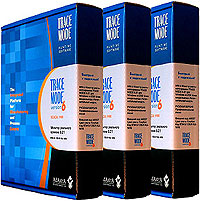 The TRACE MODE® 6 and T-FACTORY.exe® runtimes run the projects of process control and manufacturing automation systems developed in the TRACE MODE 6 Integrated development environment. Consequentially, the TRACE MODE runtimes provide the following solutions: The TRACE MODE® 6 and T-FACTORY.exe® runtimes run the projects of process control and manufacturing automation systems developed in the TRACE MODE 6 Integrated development environment. Consequentially, the TRACE MODE runtimes provide the following solutions:
Runtimes for process control (SOFTLOGIC and SCADA/HMI class) correspond to TRACE MODE, whereas the runtimes for manufacturing automation (EAM, HRM, MES class) have the T-FACTORY name. All TRACE MODE and T-FACTORY runtimes are excellently integrated between each other, and lay a unified platform for production management.
The TRACE MODE 6 and T-FACTORY 6 runtimes are conventionally subdivided into servers (nodes) and clients (consoles). This subdivision is a somewhat conventional, because a TRACE MODE console in a number of system configurations can perform functions normally attributed to servers (channel database processing, execution of programs etc.), and servers can perform functions of operator HMI, which is frequently considered to be a client task. Both client and server software is developed in a unified integrated development system and has a unified database of distributed variables, which attributes can be freely addressed by any TRACE MODE and T-FACTORY runtimes.
Such system architecture provides maximum flexibility in development of distributed control systems, because it allows building them in various architectures:
- local;
- distributed client-server;
- distributed DCS-like (distributed control system);
- remote control.
TRACE MODE SCADA/HMI has a built-in redundancy concept, so every system component may be provided with standby node.
TRACE MODE 6 SOFTLOGIC and HMI Level Runtimes in a Distributed Control System
TRACE MODE 6 development system may be used to build multilevel, hierarchically organized, redundant control and remote control systems. General structure of TRACE MODE 6 based control system (SOFTLOGIC, SCADA/HM levels), is given in a figure below.
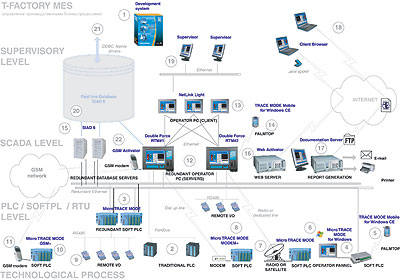 TRACE MODE 6 networking is fully based on TCP/IP protocol. TRACE MODE 6 networking is fully based on TCP/IP protocol.
Real Time Monitor - Main Real Time Server of The SCADA/HMI level
Real Time Monitor (RTM) is the main TRACE MODE® 6 SCADA/HMI runtime. It has the following main features :
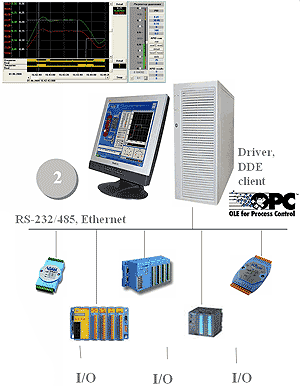 data acquisition from I/O devices via built-in and user TRACE MODE drivers, DDE and OPC. Free drivers for 2812 I/O devices are supplied along with TRACE MODE real time monitor; data acquisition from I/O devices via built-in and user TRACE MODE drivers, DDE and OPC. Free drivers for 2812 I/O devices are supplied along with TRACE MODE real time monitor;
- primary data processing - filtration, scaling, boundaries control, dead band etc.;
- process control with the IEC 6-1131/3 standard programs;
- adaptive PID loop self tuning;
- HMI visualization of information on screens and trends;
- alarming;
- process history logging in the industrial real-time database SIAD/SQL;
- statistical process control (SPC);
- report generation;
- HMI-information provision through TCP/IP network to TRACE MODE clients and servers;
- OPC-server features;
The Real time monitors with different combination of the above given features are available. Moreover, the Real Time Monitors versions with automatic hot redundancy are also available.
The RTM features powerful graphics:
- photorealistic 3D graphics;
- multiwindow interface;
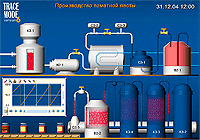 support of layers; support of layers;
- support of object transparency and superimposition of textures;
- 3D FAST+ technology, which accelerates real time loading of graphical screens;
- dynamisation of any graphical object;
- zooming of screens;
- animation;
- real time trends;
- historical trends of unlimited depth;
- events windows;
The TRACE MODE 6 SCADA/HMI RTM server has its own multithreading priority driven real time system. While operation in normal mode, minimal response time of the Real Time Monitor 6 is equal to 0.01 s (10 ms). However, the response time can be reduced by several times when using special FAST channels, which processing is performed in 2 ms cycles.
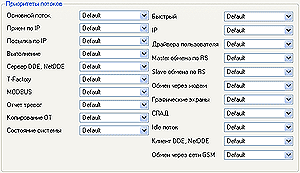 The RTM 6 real time system can be set up flexibly by means of redistribution of time resources for different threads of the computation kernel, or priorities for particular tasks. The RTM 6 real time system can be set up flexibly by means of redistribution of time resources for different threads of the computation kernel, or priorities for particular tasks.
In the respective dialogue of the integrated development environment priorities can be assigned to parameters like:
- main thread;
- IP exchange;
- operator interface;
- exchange with I/O device via driver;
- exchange with I/O device via MODBUS;
- OPC and DDE exchange, etc.
The TRACE MODE SCADA/HMI has a system of automatic network time synchronization, which allows to fix events in a distributed control system to time scale.
It is possible to perform ON LINE project editing (edit HMI interface or program logics in real time without stopping the control system). It is also possible to add or remove "pens" in the trends in real time, re-link graphic objects, change line color and stile.
TRACE MODE has a powerful alarming system, provided by a built-in alarm servers. The HMI alarms server saves text information about events occurred in the monitored process. Each message may have different statuses. The alarming system may generate and write down to alarm report an alarm message after occurrence of any king of events.
RTM with Adaptive PID-loop Self Tuning
TRACE MODE SCADA/HMI RTM with automatic (adaptive) PID-loops self tuning system is called Adaptive RTM. Adaptive RTM is based on original AdAstrA owned technology.
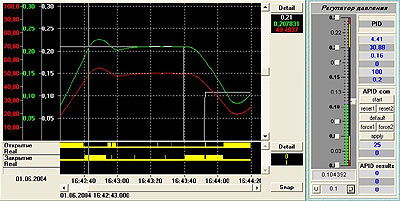 The program provides periodical or continuous online tuning of PID loops in automatic or semi-automatic mode. Adaptive RTM is able to set up control loops in noisy environments and to avoid unstable modes. The TRACE MODE SCADA/HMI adaptive PID-loops provide quality self tuning with the test signal of low amplitude (2-4%). Such small test signal fluctuations do not practically affect the control equipment and do not increase deterioration of actuators. The program provides periodical or continuous online tuning of PID loops in automatic or semi-automatic mode. Adaptive RTM is able to set up control loops in noisy environments and to avoid unstable modes. The TRACE MODE SCADA/HMI adaptive PID-loops provide quality self tuning with the test signal of low amplitude (2-4%). Such small test signal fluctuations do not practically affect the control equipment and do not increase deterioration of actuators.
Application of TRACE MODE SCADA/HMI adaptive PID-loops self tuning ensures better quality of control at any time for a wide class of stationary and non-stationary processes being automated.
Documentation Servers (Report Generators)
TRACE MODE offers 3 types of report generators:
- Local Documentation server in DocRTM+ ;
- dedicated Global Documentation server;
- dedicated Corporate Documentation server.
Besides, the report generator with the same functionality is built in the Corporate Logger.
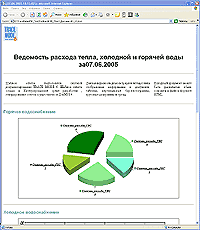 TRACE MODE Local Documentation server is designed for small control systems and for personal documentation systems. It should be installed on the same PC with TRACE MODE RTM. The server generates reports using the data from the RTM channels and save them on disk in HTML format for further printing (if required). TRACE MODE Local Documentation server is designed for small control systems and for personal documentation systems. It should be installed on the same PC with TRACE MODE RTM. The server generates reports using the data from the RTM channels and save them on disk in HTML format for further printing (if required).
- TRACE MODE Global Documentation server is designed to gather data from many RTMs in a distributed control system and to generate reports. This server should be installed on a dedicated PC. This kind of report generators can gather the data from the unlimited number of PCs and controllers and generates user reports, on the unlimited number of document templates and scripts. The reports may be saved to the hard disk in HTML format for further printing.
- The Corporate TRACE MODE Documentation server has all features of the Global one. Besides, it contains powerful communication spooler, that allow automation of the report distribution. The reports may be printed, e-mailed, sent on mobile phones, published on web sites etc.. This product is recommended for corporate scale control systems, developed with both TRACE MODE and T-FACTORY or with others HMI, DBMS and ERP.
Dedicated Server of The Industrial Real Time DBMS SIAD/SQL 6
The TRACE MODE® 6 and T-FACTORY.exe® 6 real time monitors has built-in industrial real time DBMS SIAD/SQL 6. However, it is not always expedient to save historical archive on the PC where RTM+ is operating. In case if:
- RTM+ processes a large number of channels;
- HMI-console is overloaded with graphics;
- higher demands are made in the system towards safety of data about process (physical isolation of RT DBCS server is required);
- in order to remove load from RTM+ to accelerate time parameters of control system;
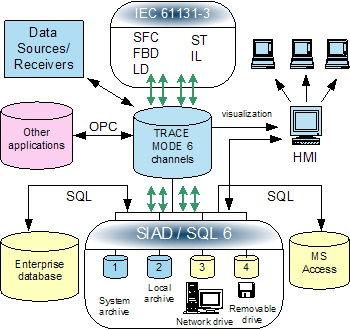 it is recommended to use a dedicated SIAD/SQL 6 real time DBMS server - Global logger on a separate PC. The history archive provided by TRACE MODE Global logger is common for the whole control system. All project nodes may save data in this log. it is recommended to use a dedicated SIAD/SQL 6 real time DBMS server - Global logger on a separate PC. The history archive provided by TRACE MODE Global logger is common for the whole control system. All project nodes may save data in this log.
The data logging is performed simultaneously into 3 files of the SIAD/SQL 6 real time DBMS. Another log is reserved for system’s needs. Due to the flexible logged parameters setup system, it is possible to save at the highest speed the history of "fast" process parameters into one file of the real time DBMS for, for example, day/week, and use another file for "slow" summary data logging about workshop production for one year.
Such logs subdivision into "fast" and "slow" would save much system resources, as compared against the "one parameter – one table – one file" method, which is frequently used in other SCADA/HMI. In combination with high speed data saving, which is 10-100 times higher than the speed of "heavy" relational DBMS, the SIAD/SQL 6 provides maximum efficiency and reliability of process history recording. The SIAD/SQL 6 real time DBMS is optimized for fast saving and reading of intensive data flows in 24x7 mode. It can save over one billion parameters with time labels accuracy of up to 1 ms. In order to provide reliability of data storage the SIAD/SQL 6 real time DBMS, provides hot redundancy (dual or triple) for servers, and the automatic data recovery system for corrupted archives.
According to the extreme testing results carried out on Pentium-IV, 3 GHz PC PC with 1 GB RAM, the real time DBMS server operating under the SIAD/SQL 6 has shown an error-free recording of over 1.000.000 changes of analogue parameters per second. Such speed is 10-100 times higher that the speed of the most competing products (the SIAD/SQL 6 real time DBMS speed tests were performed on the PC with 2 hard disks with Serial ATA interface, integrated into RAID-0 (Stripe) array).
The SIAD/SQL 6 real time DBMS server performs dynamic optimization of the information recorded, which reduces archive volume up to 10 times.
Global Logger performs statistical processing of the stored information in real time for statistical process control (SPC). The results will be displayed on the HMI screens.
Hot Redundancy for Real Time Servers and SIAD/SQL
Reliability for TRACE MODE based SCADA/HMI PCs is assured by several network adapters support and by PLC communication lines redundancy. It assumes automatic switching-over of the server to standby network adapter in real time, in case of failure of the main adapter.
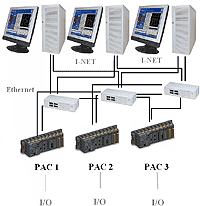 Reliability and fail-safety of distributed control systems, is provided by hot redundancy of control system servers – real time monitors, documentation servers and loggers. TRACE MODE 6 supports dual and triple redundancy features for servers as follows: Reliability and fail-safety of distributed control systems, is provided by hot redundancy of control system servers – real time monitors, documentation servers and loggers. TRACE MODE 6 supports dual and triple redundancy features for servers as follows:
- project autobuilding for automatic replication of the redundant nodes in the TRACE MODE® 6 development system;
- automatic synchronization of real time data between the master and the standby servers;
- automatic switching-over of data flows to redundant server in case of failure of the master;
- automatic identification of server status as "master" or "standby" at system startup and automatic status conflicts resolution upon recovery of the master server after failure;
- logging of all failures and switchings to standby servers.
Like sensors, I/O cards and controllers redundancy, the most reliable and fail-safe is the triple redundant configuration of the TRACE MODE® 6 servers. No wonder that triple redundant systems is most frequently used for provision of reliability in aviation.
Micro TRACE MODE - Runtime for Controllers
Micro TRACE MODE 6 is powerful multiplatform runtime designed for use in open PLC for direct digital process control. The project for Micro TRACE MODE is programmed in the Integrated Development Environment.
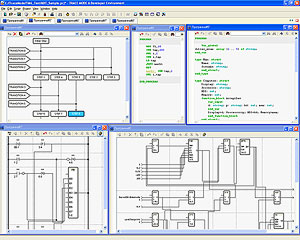 Micro RTM programming is implemented using the facilities of TRACE MODE 6 Integrated development environment (the professional line). This allows to obtain an important advantage of integrated project development: Micro RTM programming is implemented using the facilities of TRACE MODE 6 Integrated development environment (the professional line). This allows to obtain an important advantage of integrated project development:
- no duplication of databases for controller, OPC-server and HMI;
- the developers’ productivity boosted up;
- development errors reduced;
- project development cost reduced.
For Micro RTM programming, the system offers 5 languages of the international standard IEC 6-1131/3. The powerful debugging features are also available.
The developed projects can be:
- downloaded into controller directly from the TRACE MODE editors;
- remotely started up, stopped, and edited online – without shutdown of the controller.
TRACE MODE 6 Micro RTM is supplied in different configurations and provides the following features:
- Hard real time;
- System cycle starting from 2 ms;
- Built-in hot redundancy (dual and triple);
- Smooth restart;
- TCP/IP networking (I-NET protocol);
- Open format of I/O card driver;
- M-LINK protocol (serial port) support;
- Fault tolerant remote control M-LINK CRC protocol support;
- MODBUS master protocol support;
- DCS master protocol (distributed I/O device ADAM, I7000, I8000 and compatible) support;
- Program interpreter for 5 languages of the IEC 6-1131/3 standard;
- Dumping of controller parameters;
- Alarm report;
- User defined log in controller;
- Watchdog timer support;
- I/O cards support;
- Distributed I/O of ADAM 5000 series (Advantech), I7000 series (ICP DAS), I8000 series (ICP DAS) support;
- Text displays support;
- Pseudographical operator interface;
- VGA-displays support;
- Graphical operator’s interface (embedded HMI);
- Adaptive PID loop self-tuning;
- Data exchanging with PC via modem, through dedicated and dial–up phone network;
- Data exchanging with the remote RTM via GSM-modem - SMS and direct connection;
- OPC-server (optional).
The Micro TRACE MODE runtimes are available for the following operating systems:
- MS DOS;
- Mini OS7;
- Windows CE.net;
- LINUX (under development).
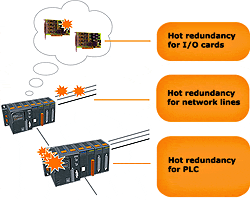 The list of operating systems remains open. Upon request, AdAstra Research, Group, Ltd can port the Micro RTM to different platforms. AdAstra Research, Group, Ltd also issues special Micro RTM versions for the various type of controllers (OEM-versions), among them: The list of operating systems remains open. Upon request, AdAstra Research, Group, Ltd can port the Micro RTM to different platforms. AdAstra Research, Group, Ltd also issues special Micro RTM versions for the various type of controllers (OEM-versions), among them:
- WinCon-8000;
- ADAM 5510;
- ICP/DAS;
- ICP/DAS i8000;
TRACE MODE ensures hot redundancy for industrial controllers programmed in Micro TRACE MODE. This type of redundancy is used, as a rule, to assure reliability of control systems at hazardous processes. Algorithms of controller redundancy can be flexibly adjusted by user and corrected in compliance with the requirements of a particular control system.
The TRACE MODE 6 reliability assurance system also includes the Watch Dog timer support, which helps to reboot controllers and industrial PCs automatically in case of the system halt.
TRACE MODE 6 SCADA/HMI Clients
NetLink Light 6 graphic console is a TRACE MODE® HMI client runtime. The NetLink Light is designed for use on additional workstations, connected to the TRACE MODE 6 servers.
TRACE MODE NetLink Light 6 has the following main features:
- real time data exchange with TRACE MODE servers, e.g. RTM, RTM+ or its modifications, as well as with Global Logger and with controllers run under Micro RTM;
- data processing with the IEC 6-1131/3 standard programs;
- process visualization in HMI screens and trends;
- visualization of the process history from SIAD/SQL 6 or from relational DBMS;
- supervisory control via the TRACE MODE servers.
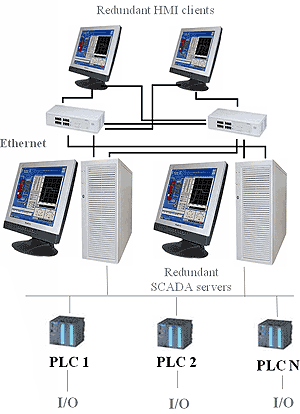 The NetLink Light 6 based HMI is represented in the TRACE MODE 6 project as a separate node having its own network TCP/IP address. The NetLink Light node does not contain its own I/O channels, but only the calls of HMI screens and programs. The HMI screens can be copied from any node of the project, or designed specially for the console. The NetLink Light 6 based HMI is represented in the TRACE MODE 6 project as a separate node having its own network TCP/IP address. The NetLink Light node does not contain its own I/O channels, but only the calls of HMI screens and programs. The HMI screens can be copied from any node of the project, or designed specially for the console.
The NetLink Light 6 based HMI can connect to servers through all physical interfaces available in TRACE MODE, e.g.:
- TCP/IP local area network;
- Internet;
- RS 232/485;
- modem on dedicated phone line;
- modem on dialup line;
- GSM SMS based network;
One NetLink Light 6 can connect simultaneously to many TRACE MODE 6 servers, therefore the NetLink Light 6 HMI screens can display the information received from different TRACE MODE RTMs, RTM+ and Micro RTMs. It is possible to connect the unlimited number of NetLink Light 6 HMI clients to a single TRACE MODE server.
TRACE MODE 6 Runtimes for Remote Control
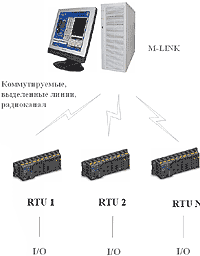 TRACE MODE 6 SCADA/HMI can be efficiently used in remote control systems on the basis of the following interfaces: TRACE MODE 6 SCADA/HMI can be efficiently used in remote control systems on the basis of the following interfaces:
- dedicated telephone line (modem);
- dialup telephone line;
- radio channel;
- Wi-Fi;
- GSM network.
The first four interfaces are supported by conventional TRACE MODE SCADA/HMI servers – Real Time Monitors. For GSM based remote control the TRACE MODE GSM-RTM+ should be used.
In order to build a TRACE MODE based remote control system one should install the TRACE MODE SOFTLOGIC runtimes in the remote controllers (RTU) - Micro TRACE MODE, Micro TRACE MODE Modem+, Micro TRACE MODE GSM. Such software configuration provides the following features, necessary for efficient operation of remote control systems:
- remote terminal units (RTU) polling by operator PCs;
- graphical HMI visualization of data acquired;
- remote process control by operator;
- local logical and PID control by remote RTUs;
- delivery control for each message;
- fixing the RTU time for events and "lifting" this time marks to SCADA/HMI;
- logging on remote RTU and periodical transmission of data to SCADA/HMI;
- making a central data log in SCADA/HMI PC;
- alarming;
- trending;
- synchronization of time for all nodes of the remote control system;
In a normal mode, RTM+ performs cyclic polling of RTU units operating under control of Micro TRACE MODE Modem +, gather the accumulated data from RTU local archives, processes them and adds to SIAD/SQL, classifying by the time registered by RTU. SCADA/HMI-server also analyses alarms and in case of emergency can shift to emergency mode with capture of remote terminal unit.
In order to provide reliable communication with remote controllers (RTU) TRACE MODE has built-in special antinoise remote control protocol M-LINK CRC.
TRACE MODE GSM-RTM+ has all features of the standard TRACE MODE RTM+, besides it includes the GSM-server, that provides the following features:
- data exchanging via GSM-modem by SMS with:
o remote controllers (RTU), controlled by the Micro TRACE MODE GSM+;
o remote RTM+ (HMI runtimes);
o GSM mobile phones;
o DBMC and others applications (via OPC и ODBC);
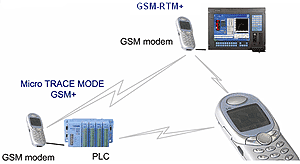 alarm generation, visualization and further transmition to the GSM mobile phones and/PCs; alarm generation, visualization and further transmition to the GSM mobile phones and/PCs;
- transmitting of operator’s interactive messages to the GSM mobile phones and/PCs;
- providing the requested TRACE MODE и T-Factory channels data in numerical and text format;
- DBMC data querying from the GSM mobile phones (MS SQL Server, MS Access, Oracle, DB2, Sybase etc);
The Micro TRACE MODE GSM+ и GSM-RTM+ based remote control systems provide protection against unauthorized access. These programs offer the access control by the SIM card number, and also the control of the valid operations. TRACE MODE GSM-RTM+ remote control systems are fully integrated into the TRACE MODE and T-Factory security system.
T-FACTORY 6 Runtimes for MES, EAM and HRM Applications
Together with process control , a manufacturing automation system may be build in the integrated development system. The MES, EAM and HRM applications are run under T-FACTORY.exe® runtimes.
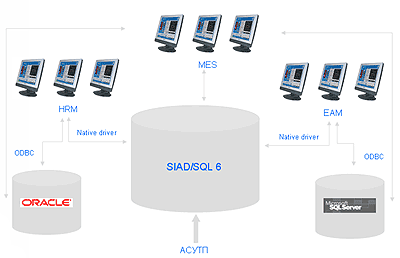
T-FACTORY Server: MES/EAM/HRM
The main runtime for manufacturing automation system is T-FACTORY RTM+. T-FACTORY RTM+ provides:
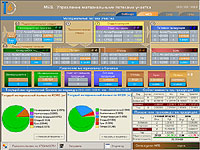 calculating material and energy balances between any elements of technological chain; calculating material and energy balances between any elements of technological chain;
- analyzing the material and energy losses at any technological stage;
- generating production orders;
- generating material and works orders on the base of production orders, automatically and forwarding the same to the executors;
- performing network planning for production works;
- controlling the execution of works;
- controlling the quality using the process-oriented approach, complying with ISO 9000:2000 international standard;
- calculating the manufacturing cost in real time, at each technological stage;
- revealing "bottlenecks" of the production – the reasons of growth of the manufacturing cost, wastage, losses, deviations from the terms of execution, etc.;
- monitoring of compliance of time and cost of production orders execution with the planned targets;
- logging the MES-statistics of operation, downtime, failures and maintenance of equipment;
- generating reports automatically, and calculating the indices, required for decision making.
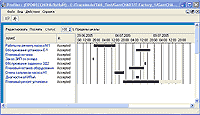 elaborating the EAM services for preventive and predictive maintenance; elaborating the EAM services for preventive and predictive maintenance;
- assigning maintenance priorities;
- linking the maintenance services with real time data from TRACE MODE HMI and SOFTLOGIC;
- automatically generate EAM orders for materials and works;
- setting up the EAM document flow circulation rules with approval of stages by the personnel in charge;
- performing network planning for maintenance works, for an unlimited period;
- controlling the execution of works;
- logging the EAM-statistics of operation, downtime, failures and maintenance of equipment;
- accounting of the maintenance cost;
- account for executed works;
- transmit the information about execution of works to external applications for calculation of pay and bonuses;
- perform network planning of the works;
- perform work management - supervision of the execution of works;
- save statistics of work execution and downtime of the personnel;
- account for the labor cost.
The T-FACTORY RTM normally uses the real time DBMS SIAD/SQL 6 for data storage. User reports containing statistics for MES, EAM and HRM can be generated using TRACE MODE documentation server.
T-FACTORY Client: MES/EAM/HRM
T-Factory NetLink Light 6 is a graphic console runtime for MES/EAM/HRM applications. It performs visualisation of data received from the T-FACTORY and TRACE MODE servers. The T-Factory NetLink Light is suitable for use on additional MES, EAM, HRM workstations, connected to the servers.
The graphic features of T-Factory NetLink Light are equal to those of the server. One client can connect simultaneously to many TRACE MODE 6 servers.
The T-FACTORY 6 NetLink Light has a lower price than the server and can be used for optimisation of cost in the MES, EAM and HRM applications. |









 The TRACE MODE® 6 and T-FACTORY.exe® runtimes run the projects of process control and manufacturing automation systems developed in the TRACE MODE 6 Integrated development environment. Consequentially, the TRACE MODE runtimes provide the following solutions:
The TRACE MODE® 6 and T-FACTORY.exe® runtimes run the projects of process control and manufacturing automation systems developed in the TRACE MODE 6 Integrated development environment. Consequentially, the TRACE MODE runtimes provide the following solutions: TRACE MODE 6 networking is fully based on TCP/IP protocol.
TRACE MODE 6 networking is fully based on TCP/IP protocol. data acquisition from I/O devices via built-in and user TRACE MODE drivers, DDE and OPC. Free drivers for 2812 I/O devices are supplied along with TRACE MODE real time monitor;
data acquisition from I/O devices via built-in and user TRACE MODE drivers, DDE and OPC. Free drivers for 2812 I/O devices are supplied along with TRACE MODE real time monitor;
 support of layers;
support of layers;
 The RTM 6 real time system can be set up flexibly by means of redistribution of time resources for different threads of the computation kernel, or priorities for particular tasks.
The RTM 6 real time system can be set up flexibly by means of redistribution of time resources for different threads of the computation kernel, or priorities for particular tasks.  The program provides periodical or continuous online tuning of PID loops in automatic or semi-automatic mode. Adaptive RTM is able to set up control loops in noisy environments and to avoid unstable modes. The TRACE MODE SCADA/HMI adaptive PID-loops provide quality self tuning with the test signal of low amplitude (2-4%). Such small test signal fluctuations do not practically affect the control equipment and do not increase deterioration of actuators.
The program provides periodical or continuous online tuning of PID loops in automatic or semi-automatic mode. Adaptive RTM is able to set up control loops in noisy environments and to avoid unstable modes. The TRACE MODE SCADA/HMI adaptive PID-loops provide quality self tuning with the test signal of low amplitude (2-4%). Such small test signal fluctuations do not practically affect the control equipment and do not increase deterioration of actuators.  TRACE MODE Local Documentation server is designed for small control systems and for personal documentation systems. It should be installed on the same PC with TRACE MODE
TRACE MODE Local Documentation server is designed for small control systems and for personal documentation systems. It should be installed on the same PC with TRACE MODE  it is recommended to use a dedicated SIAD/SQL 6 real time DBMS server -
it is recommended to use a dedicated SIAD/SQL 6 real time DBMS server -  Reliability and fail-safety of distributed control systems, is provided by hot redundancy of control system servers –
Reliability and fail-safety of distributed control systems, is provided by hot redundancy of control system servers –  Micro RTM programming is implemented using the facilities of
Micro RTM programming is implemented using the facilities of  The list of operating systems remains open. Upon request, AdAstra Research, Group, Ltd can port the Micro RTM to different platforms. AdAstra Research, Group, Ltd also issues
The list of operating systems remains open. Upon request, AdAstra Research, Group, Ltd can port the Micro RTM to different platforms. AdAstra Research, Group, Ltd also issues  The NetLink Light 6 based HMI is represented in the TRACE MODE 6 project as a separate node having its own network TCP/IP address. The NetLink Light node does not contain its own I/O channels, but only the calls of HMI screens and programs. The HMI screens can be copied from any node of the project, or designed specially for the console.
The NetLink Light 6 based HMI is represented in the TRACE MODE 6 project as a separate node having its own network TCP/IP address. The NetLink Light node does not contain its own I/O channels, but only the calls of HMI screens and programs. The HMI screens can be copied from any node of the project, or designed specially for the console.  TRACE MODE 6 SCADA/HMI can be efficiently used in remote control systems on the basis of the following interfaces:
TRACE MODE 6 SCADA/HMI can be efficiently used in remote control systems on the basis of the following interfaces: alarm generation, visualization and further transmition to the GSM mobile phones and/PCs;
alarm generation, visualization and further transmition to the GSM mobile phones and/PCs;

 calculating material and energy balances between any elements of technological chain;
calculating material and energy balances between any elements of technological chain;
 elaborating the EAM services for preventive and predictive maintenance;
elaborating the EAM services for preventive and predictive maintenance;
